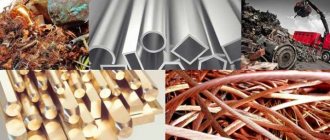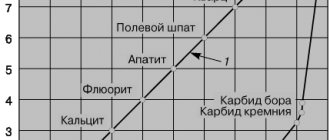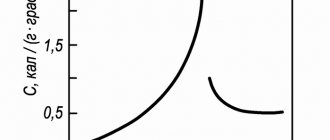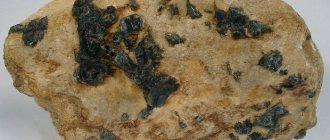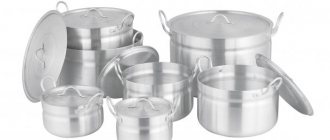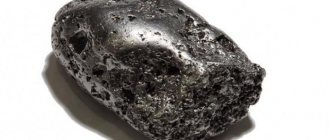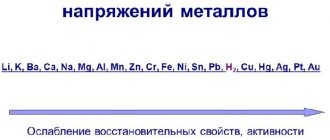Lead
- a rare mineral, a native metal of the class of native elements. Malleable, relatively fusible metal of silver-white color with a bluish tint. Known since ancient times. Very plastic, soft (can be cut with a knife, scratched with a fingernail). Nuclear reactions produce numerous radioactive isotopes of lead.
- Structure
- Properties
- Reserves and production
- Origin
- Application
- Classification
- Physical properties
- Optical properties
- Crystallographic properties
See also:
Silver
— structure and physical properties
PROPERTIES
Lead has a rather low thermal conductivity, it is 35.1 W/(m•K) at a temperature of 0 °C. The metal is soft, can be cut with a knife, and is easily scratched with a fingernail. On the surface it is usually covered with a more or less thick film of oxides; when cut, a shiny surface is revealed, which fades over time in air. Melting point - 600.61 K (327.46 °C), boils at 2022 K (1749 °C). Belongs to the group of heavy metals; its density is 11.3415 g/cm3 (+20 °C). As the temperature increases, the density of lead decreases. Tensile strength - 12-13 MPa (MN/m2). At a temperature of 7.26 K it becomes a superconductor.
What color is the metal?
It is an element of group IV of period 6 of the periodic table, where it has the serial number 82. What is lead in nature? This is the most commonly found galena, the formula of which is PbS. Otherwise, galena is called lead luster. The pure element is a soft and malleable metal of a dirty gray color. In air, its cut quickly becomes covered with a small layer of oxide. Oxides reliably protect the metal from further oxidation in both wet and dry environments. If a metal surface coated with oxides is cleaned, it will acquire a shiny tint with a blue tint. This cleaning can be done by pouring the lead in a vacuum and sealing it into a vacuum flask.
RESERVES AND PRODUCTION
The content in the earth's crust is 1.6•10−3% by mass. Native lead is rare; the range of rocks in which it is found is quite wide: from sedimentary rocks to ultramafic intrusive rocks. In these formations it often forms intermetallic compounds (for example, zvyagintsevite (Pd,Pt)3(Pb,Sn), etc.) and alloys with other elements (for example, (Pb + Sn + Sb)). It is part of 80 different minerals. The most important of them are: galena PbS, cerussite PbCO3, anglesite PbSO4 (lead sulfate); of the more complex ones - tillite PbSnS2 and betechtinite Pb2(Cu,Fe)21S15, as well as lead sulfosalts - jamesonite FePb4Sn6S14, boulangerite Pb5Sb4S11. Always found in uranium and thorium ores, often having a radiogenic nature.
To obtain lead, ores containing galena are mainly used. First, a concentrate containing 40-70 percent lead is obtained by flotation. Then, several methods are possible for processing the concentrate into werkbley (blank lead): the formerly widespread method of mine reduction smelting, the method of oxygen-suspended cyclone electrothermal smelting of lead-zinc products (KIVTSET-TSS), the Vanyukov smelting method (melting in a liquid bath) developed in the USSR. . For smelting in a shaft (water jacket) furnace, the concentrate is first sintered and then loaded into a shaft furnace, where lead is reduced from the oxide.
Werkbley, containing more than 90 percent lead, undergoes further purification. First, zeigerization and subsequent sulfur treatment are used to remove copper. Arsenic and antimony are then removed by alkaline refining. Next, silver and gold are isolated using zinc foam and the zinc is distilled off. Bismuth is removed by treatment with calcium and magnesium. As a result, the impurity content drops to less than 0.2%[
Heavy metal in industry
The most commonly used in industry is a compound of lead and tin. Ordinary solder called "tertiary" is widely used for connecting pipelines and electrical wires. This compound contains one part lead and two parts tin. Sheaths for telephone cables and parts of batteries may also contain lead. The melting point of some of its compounds is very low - for example, alloys with cadmium or tin melt at 70 °C. Fire-fighting equipment is made from such compounds. Metal alloys are widely used in shipbuilding. They are usually colored light gray. Ships are often coated with tin and lead alloys to protect against corrosion.
ORIGIN
It forms impregnations in igneous, mainly acidic rocks; in deposits of Fe and Mn it is associated with magnetite and hausmannite. Found in placers with native Au, Pt, Os, Ir.
Under natural conditions, it often forms large deposits of lead-zinc or polymetallic ores of the stratiform type (Kholodninskoye, Transbaikalia), as well as skarn (Dalnegorskoye (formerly Tetyukhinskoye), Primorye; Broken Hill in Australia) type; galena is often found in deposits of other metals: pyrite-polymetallic (Southern and Middle Urals), copper-nickel (Norilsk), uranium (Kazakhstan), gold ore, etc. Sulfosalts are usually found in low-temperature hydrothermal deposits with antimony, arsenic, and also in gold deposits (Darasun, Transbaikalia). Lead minerals of the sulfide type have a hydrothermal genesis, minerals of the oxide type are common in weathering crusts (oxidation zones) of lead-zinc deposits. Lead is present in clarke concentrations in almost all rocks. The only place on earth where rocks contain more lead than uranium is the Kohistan-Ladakh arc in northern Pakistan.
Harm
Every schoolchild knows what lead is. But not all adults are able to answer the question of what its harm is. Its particles enter the body through the respiratory system. Next, it begins to interact with the blood, reacting with various parts of the body. The musculoskeletal system suffers the most from this. This is where 95% of all lead consumed by humans ends up.
High levels of it in the body lead to mental retardation, and in adults it manifests itself in the form of depressive symptoms. Excess is indicated by absent-mindedness and fatigue. The intestines also suffer – due to lead, spasms can often occur. This heavy metal also negatively affects the reproductive system. Women find it difficult to bear a child, and men may experience problems with sperm quality. It is also very dangerous for the kidneys. According to some studies, it can cause malignant tumors. However, in amounts not exceeding 1 mg, lead can be beneficial to the body. Scientists have found that this metal can have a bactericidal effect on the organs of vision - however, you should remember what lead is and use it only in doses not exceeding the permissible limits.
APPLICATION
Lead nitrate is used to produce powerful mixed explosives. Lead azide is used as the most widely used detonator (initiating explosive). Lead perchlorate is used to prepare a heavy liquid (density 2.6 g/cm³) used in flotation beneficiation of ores, and it is sometimes used in high-power mixed explosives as an oxidizing agent. Lead fluoride alone, as well as together with bismuth, copper, and silver fluoride, is used as a cathode material in chemical current sources.
Lead bismuthate, lead sulfide PbS, lead iodide are used as cathode material in lithium batteries. Lead chloride PbCl2 as a cathode material in backup current sources. Lead telluride PbTe is widely used as a thermoelectric material (thermo-emf 350 µV/K), the most widely used material in the production of thermoelectric generators and thermoelectric refrigerators. Lead dioxide PbO2 is widely used not only in lead batteries, but also on its basis many reserve chemical current sources are produced, for example, lead-chlorine cell, lead-fluorescent cell and others.
Lead white, basic carbonate Pb(OH)2•PbCO3, dense white powder, is obtained from lead in air under the influence of carbon dioxide and acetic acid. The use of white lead as a coloring pigment is no longer as common as it once was due to its decomposition by hydrogen sulfide H2S. Lead white is also used for the production of putty, in the technology of cement and lead carbonate paper.
Lead arsenate and arsenite are used in insecticide technology to kill agricultural pests (gypsy moth and cotton boll weevil).
Lead borate Pb(BO2)2•H2O, an insoluble white powder, is used to dry paintings and varnishes, and, along with other metals, as coatings on glass and porcelain.
Lead chloride PbCl2, a white crystalline powder, is soluble in hot water, solutions of other chlorides and especially ammonium chloride NH4Cl. It is used to prepare ointments for treating tumors.
Lead chromate PbCrO4 is known as chrome yellow dye and is an important pigment for making paints, for dyeing porcelain and fabrics. In industry, chromate is used mainly in the production of yellow pigments.
Lead nitrate Pb(NO3)2 is a white crystalline substance, highly soluble in water. This is a binder of limited use. In industry, it is used in matchmaking, textile dyeing and printing, antler dyeing and engraving.
Since lead absorbs γ radiation well, it is used for radiation protection in X-ray facilities and in nuclear reactors. In addition, lead is considered as a coolant in projects of advanced fast neutron nuclear reactors.
Lead alloys are widely used. Pewter (tin-lead alloy), containing 85–90% Sn and 15–10% Pb, is moldable, inexpensive, and used in the manufacture of household utensils. Solder containing 67% Pb and 33% Sn is used in electrical engineering. Alloys of lead and antimony are used in the production of bullets and typographic fonts, and alloys of lead, antimony and tin are used for figured casting and bearings. Lead-antimony alloys are commonly used for cable sheaths and electric battery plates. There was a time when cable sheaths used a significant portion of the world's lead production, due to the good moisture-proof properties of such products. However, lead was subsequently largely replaced from this area by aluminum and polymers. Thus, in Western countries, the use of lead on cable sheaths fell from 342 thousand tons in 1976 to 51 thousand tons in 2002. Lead compounds are used in the production of dyes, paints, insecticides, glass products and as an additive to gasoline in the form of tetraethyl lead (C2H5)4Pb (a moderately volatile liquid, the vapors of which in small concentrations have a sweetish fruity odor, in large concentrations - an unpleasant odor; Tm = 130 ° C, Bp = +80 °C/13 mm Hg; density 1.650 g/cm³; nD2v = 1.5198; insoluble in water, miscible with organic solvents; highly toxic, easily penetrates skin; MPC = 0.005 mg/ m³; LD50 = 12.7 mg/kg (rat, oral)) to increase octane number.
Used to protect patients from radiation from X-ray machines.
Lead - Pb
| Molecular weight | 207.20 g/mol |
| origin of name | from Latin plumbum |
| IMA status | valid, first described before 1959 (before IMA) |
Interaction with other metals, heating
The specific heat capacity of lead is 140 J/kg. According to its chemical properties, it is a low-active metal. In the voltage series it is located in front of hydrogen. Lead is easily replaced from its salts by other metals. For example, you can conduct an experiment: dip a zinc stick into a solution of acetate of this element. Then it will settle on the zinc stick in the form of fluffy crystals, which chemists call “Saturn wood.” What is the specific heat of lead? What does this mean? This figure is 140 J/kg. This means the following: to heat a kilogram of metal by 1 °C, 140 Joules of heat are required.
PHYSICAL PROPERTIES
| Mineral color | gray, usually covered with a white coating of hydrocerussite |
| Stroke color | grey |
| Transparency | opaque |
| Shine | metal |
| Cleavage | No |
| Hardness (Mohs scale) | 1,5 |
| Strength | malleable, malleable, cut with a knife |
| Kink | serrated, hooked |
| Density (measured) | 11.37 g/cm3 |
| Radioactivity (GRapi) | 0 |
| Magnetism | diamagnetic |
Historical information
Lead has been used for thousands of years because it is widespread and easy to mine and process. It is very malleable and melts easily. Lead smelting was the first metallurgical process known to man. Lead beads dating back to 6400 BC. BC, were found in the Çatalhöyük culture. The oldest object made of lead is often considered to be a figurine of a standing woman in a long skirt from the First Dynasty of Egypt, dating back to 3100-2900. BC BC, stored in the British Museum (stock number EA 32138). It was found in the Temple of Osiris at Abydos and brought from Egypt in 1899. In Ancient Egypt, lead medallions were used. In the Early Bronze Age, lead was used along with antimony and arsenic. Lead is referred to as a specific metal in the Old Testament.
Lead pipes of an ancient Roman water supply with inscriptions
The largest producer of lead in the pre-industrial era was Ancient Rome, with an annual production of 80,000 tons. Roman mining of lead took place in Central Europe, Roman Britain, the Balkans, Greece, Asia Minor and Spain. The Romans widely used lead in the production of pipes for water supply systems, and lead pipes often bore the inscriptions of Roman emperors. True, even Pliny and Vitruvius believed that this was not good for public health.
Papal bull of 1637 with lead seal
After the fall of the Roman Empire in the 5th century. n. e. Lead use in Europe fell and remained low for about 600 years. Then lead began to be mined in eastern Germany. Lead sugar has been added to wine since Roman times to improve its taste; this became widespread and continued even after the ban by a papal bull in 1498. This use of lead in the Middle Ages led to epidemics of lead colic. In Ancient Rus', lead was used to cover the roofs of churches, and was also widely used as a material for hanging seals on letters. Later, in 1633, a water supply system with lead pipes was built in the Kremlin, through which water came from the Vodovzvodnaya Tower; it existed until 1737.
In alchemy, lead was associated with the planet Saturn and was represented by its symbol ♄. In ancient times, tin, lead and antimony were often not distinguished from each other, considering them to be different types of the same metal, although Pliny the Elder distinguished between tin and lead, calling tin “plumbum album”, and lead “plumbum nigrum”.
The Industrial Revolution led to a new increase in the demand for lead. By the beginning of the 1840s. annual production of refined lead exceeded 100,000 tons for the first time and grew to over 250,000 tons over the next 20 years. Until the last decades of the 19th century, lead mining was primarily carried out by three countries: Britain, Germany and Spain. By the beginning of the 20th century, lead mining in Europe had become less than in the rest of the world, thanks to increased production in the United States, Canada, Mexico and Australia. Until 1990, large quantities of lead were used (together with antimony and tin) to cast typographical fonts, and also in the form of tetraethyl lead to increase the octane number of motor fuels.
The effect of lead on the human body and symptoms of poisoning
Any lead compounds are very poisonous. The metal enters the body along with food or inhaled air and is carried by the blood. Moreover, inhaling lead vapors and dust is much more dangerous than its presence in food. Lead tends to accumulate in bones, partially replacing calcium in this case. When the concentration of lead in the body increases, anemia develops, the brain is affected, which leads to a decrease in intelligence, and in children it can cause irreversible developmental delays. It is enough to dissolve one milligram of lead in a liter of water and it will become not only unsuitable, but also dangerous for drinking. Such a low amount of lead also poses a certain danger; neither the color nor the taste of the water changes. Main symptoms of lead poisoning:
- gray border on the gums,
- lethargy,
- apathy,
- memory loss,
- dementia,
- vision problems,
- early aging.
